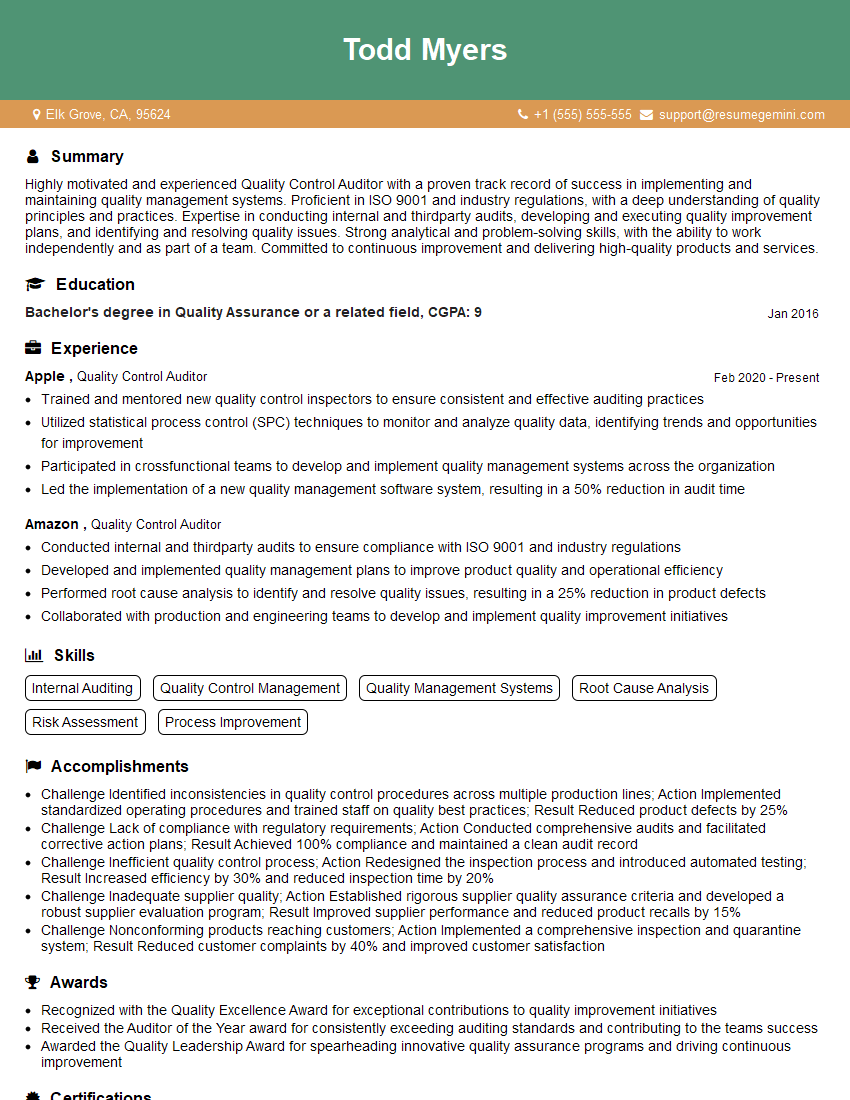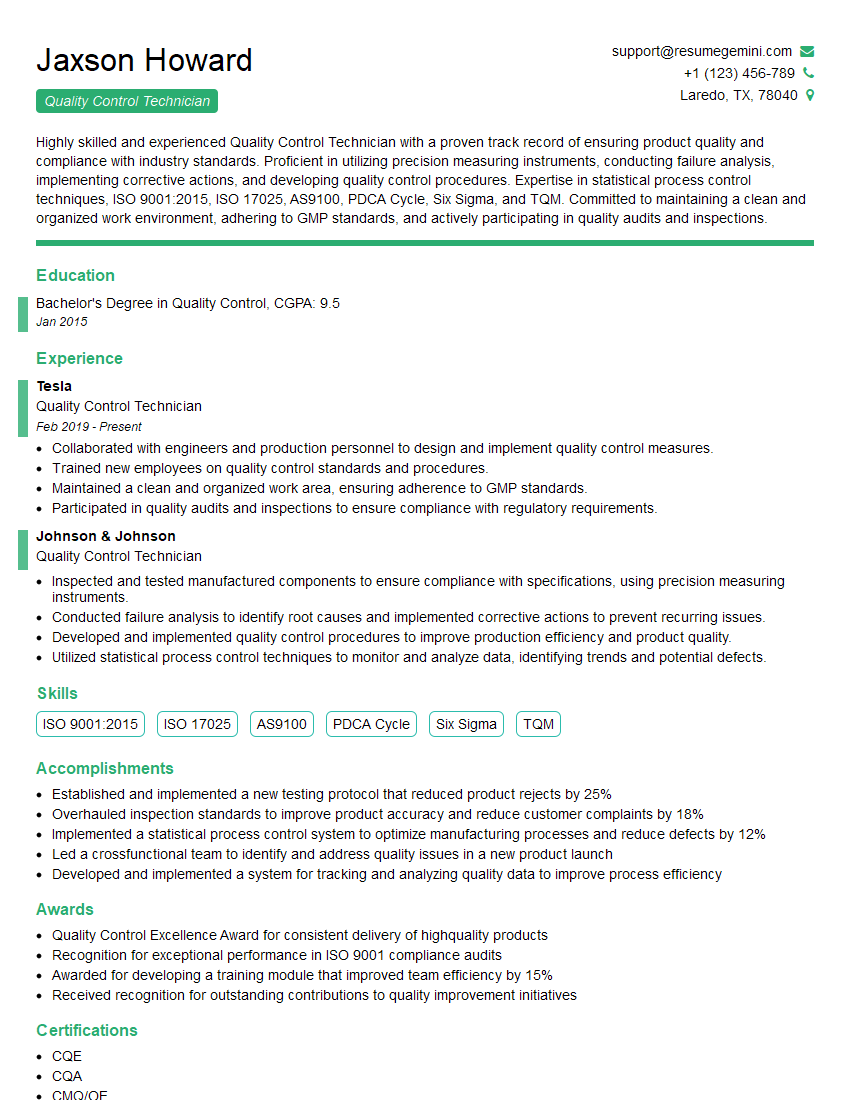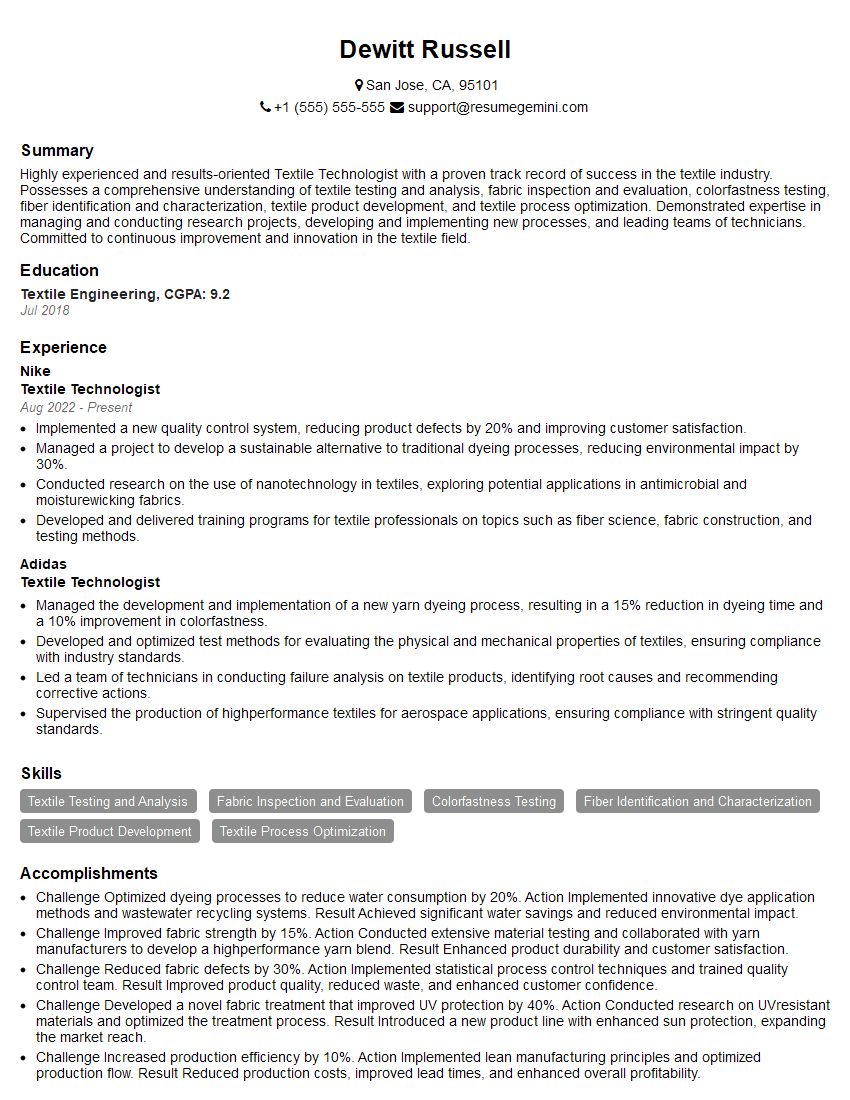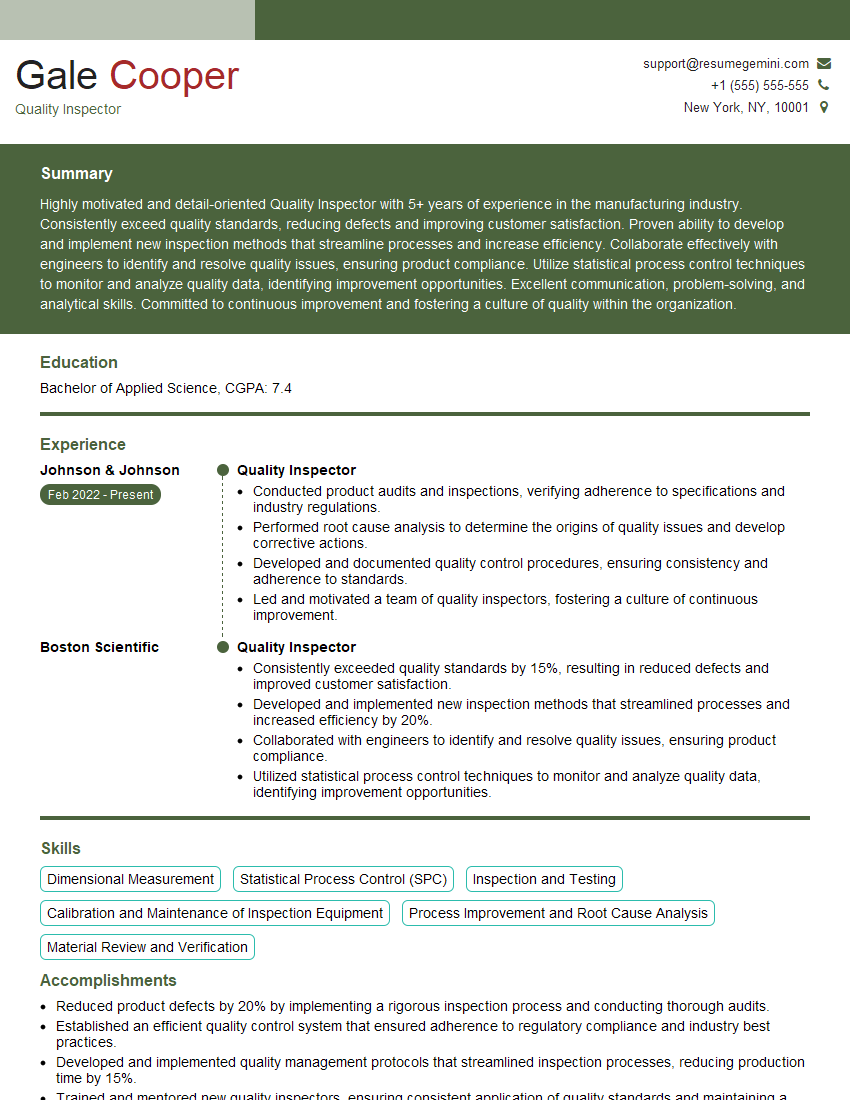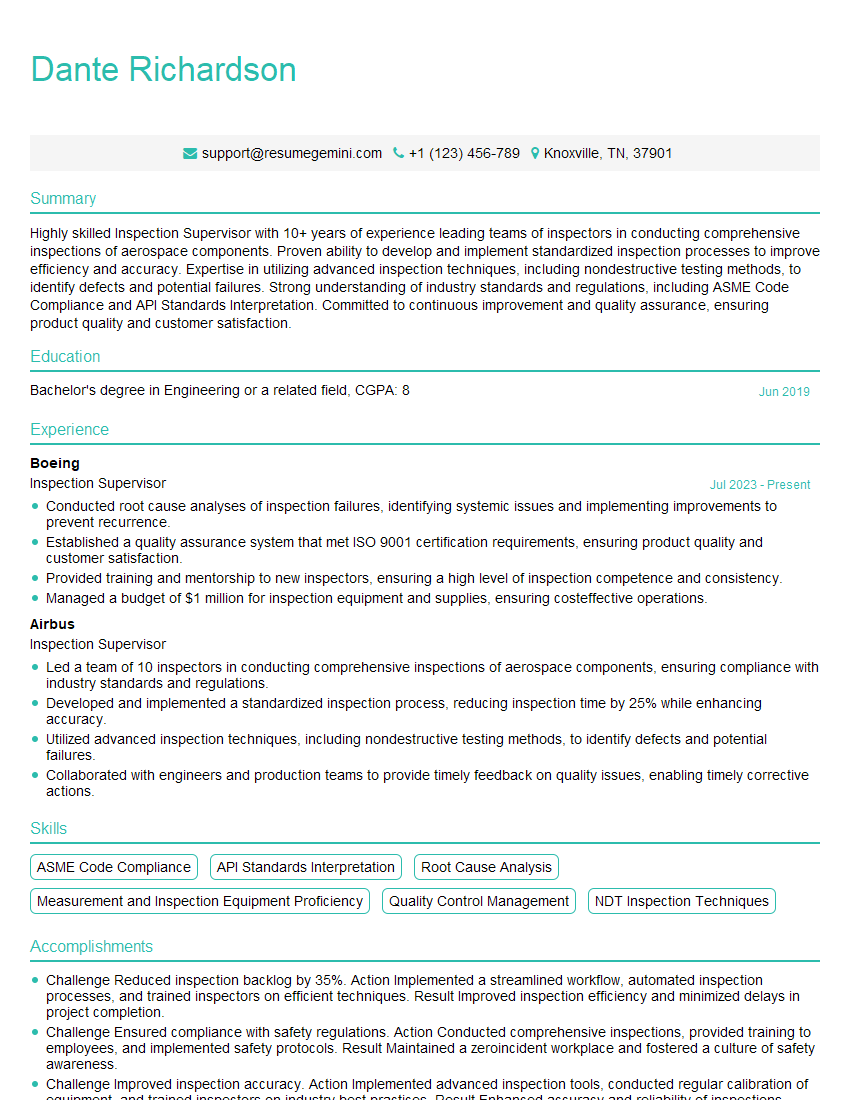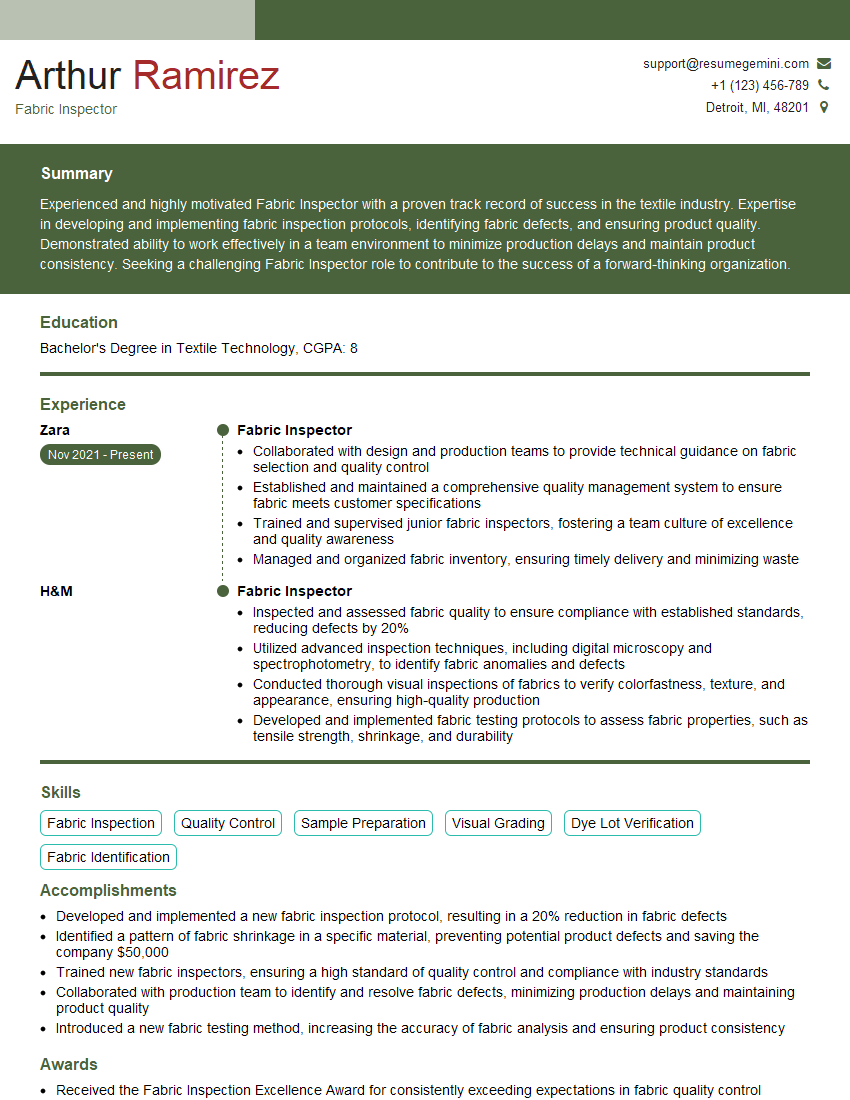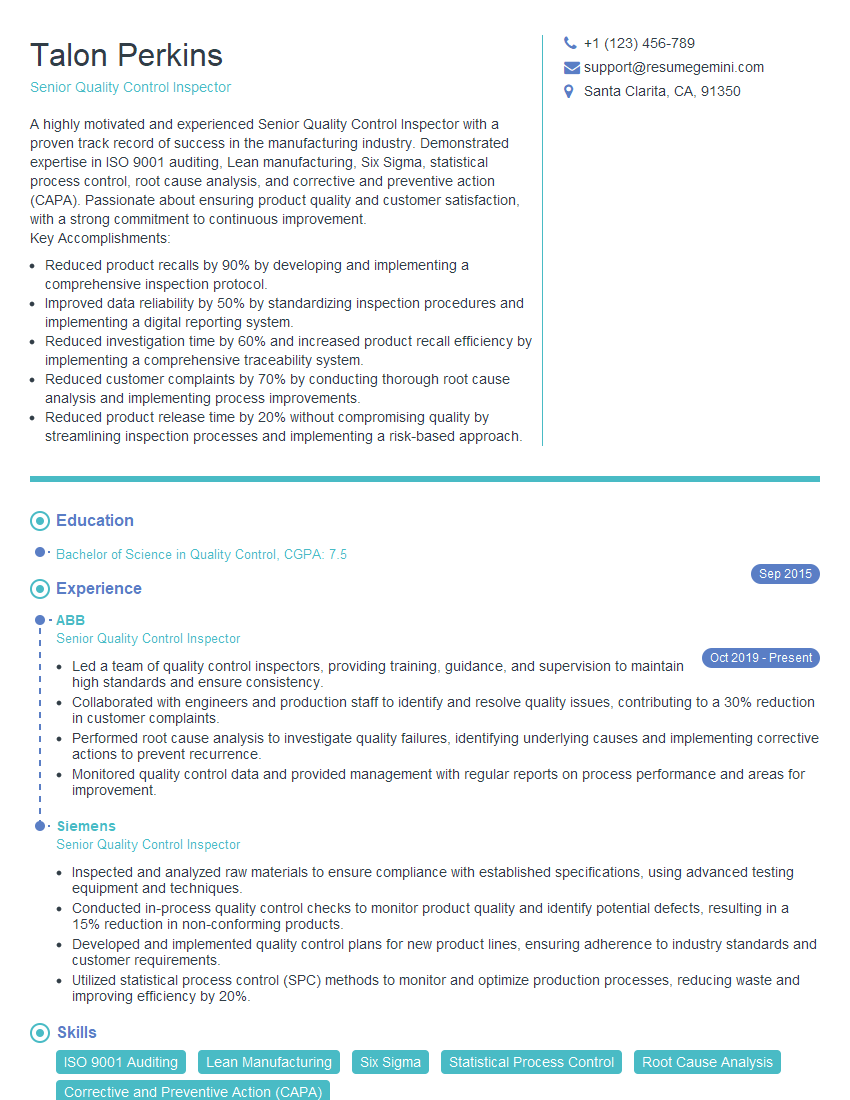Preparation is the key to success in any interview. In this post, we’ll explore crucial Quality Control and Fabric Inspection interview questions and equip you with strategies to craft impactful answers. Whether you’re a beginner or a pro, these tips will elevate your preparation.
Questions Asked in Quality Control and Fabric Inspection Interview
Q 1. Explain the concept of Acceptable Quality Limit (AQL).
Acceptable Quality Limit (AQL) is a statistical measure used in quality control to define the maximum acceptable percentage of defective units in a batch of goods. It’s not about achieving zero defects, which is often impractical and cost-prohibitive, but rather setting a reasonable threshold for acceptable imperfection. Think of it like this: AQL sets the line between ‘good enough’ and ‘needs improvement’. It’s based on the idea that some level of defects is inevitable in any manufacturing process.
AQL is expressed as a percentage. For example, an AQL of 2.5% means that, statistically, up to 2.5% of the inspected units can be defective and the batch would still be considered acceptable. The specific AQL level chosen depends on several factors including the criticality of the product, customer requirements, and the cost of inspection and rejection.
Different AQL levels exist for different inspection levels (e.g., General Inspection Level II, Reduced Inspection Level I). Choosing the appropriate AQL and inspection level ensures a balance between quality assurance and cost-effectiveness.
Q 2. Describe different fabric defect types (e.g., weaving, dyeing).
Fabric defects can arise at various stages of production, from weaving to dyeing and finishing. Here are some examples:
- Weaving Defects: These include broken ends (where yarns break during weaving), missing ends (yarns completely absent), slubs (thickened areas in yarn), holes, and mispicks (incorrect interlacing of warp and weft yarns). Imagine a perfectly woven tapestry – any deviation from its precise pattern represents a weaving defect.
- Dyeing Defects: These relate to the application of color. Common issues include uneven dyeing (resulting in shading or color variations), staining (unwanted marks or discoloration), crocking (color transfer to other fabrics), and bleeding (color fading or running in water).
- Finishing Defects: After dyeing, fabrics undergo finishing processes like calendaring, washing, and shrinking. Defects here can include creases, wrinkles, shrinkage variations, and damage caused by improper handling.
- Other Defects: Beyond these, there are defects like impurities (foreign matter embedded in fabric), contamination (e.g., oil stains), and damage during handling and transportation.
Identifying the root cause of these defects is crucial for implementing corrective actions and preventing recurrence.
Q 3. How do you perform a fabric inspection using AQL standards?
Performing a fabric inspection using AQL standards involves a systematic approach. It’s not just a random check; it’s a statistically-based sampling procedure.
- Determine the AQL and Inspection Level: This is usually pre-agreed upon with the client or based on industry standards. For example, an AQL of 2.5% with Inspection Level II might be chosen.
- Sampling Plan: Based on the AQL and inspection level, a sampling plan dictates the number of samples to be inspected from the entire batch. Tables are available (MIL-STD-105E is a common reference) that provide the required sample size based on the lot size.
- Inspection: Carefully examine each sample, meticulously noting the type and number of defects. Tools like magnifying glasses and measuring instruments might be employed. It’s important to maintain consistency in defect classification.
- Defect Classification: Categorize each defect based on its severity (critical, major, minor). Critical defects are those that seriously impact product safety or functionality. Major defects affect performance but aren’t critical safety issues. Minor defects are those with negligible impact.
- Acceptance/Rejection: Compare the number of defects found (both total and per defect category) against the AQL tables. If the number of defects falls within or below the AQL, the batch is usually accepted. Otherwise, rejection or further inspection is necessary.
This process ensures a statistically sound judgment of the entire batch’s quality based on the inspected sample.
Q 4. What are the common fabric testing methods?
Common fabric testing methods cover a wide range of properties:
- Tensile Strength: Measures the fabric’s resistance to pulling forces.
- Bursting Strength: Assesses the fabric’s resistance to pressure applied until it bursts.
- Abrasion Resistance: Determines the fabric’s ability to withstand friction and wear.
- Colorfastness: Evaluates the fabric’s resistance to fading due to washing, light, or perspiration.
- Shrinkage: Measures the change in fabric dimensions after washing or drying.
- Wrinkle Resistance: Assesses the fabric’s tendency to wrinkle.
- Water Absorption: Determines how much water the fabric can absorb.
- Air Permeability: Measures the fabric’s breathability.
These tests help ensure that the fabric meets the required quality standards for its intended use. Different test methods might be used for different fabric types based on their unique properties.
Q 5. Explain your experience with different fabric types (e.g., cotton, silk, polyester).
My experience encompasses a broad range of fabric types, including cotton, silk, polyester, and blends. I understand the unique characteristics and potential defects associated with each:
- Cotton: I’m proficient in inspecting cotton fabrics for common defects like slubs, neps (small knots in the yarn), uneven dyeing, and variations in strength due to fiber length and processing. Cotton’s natural variations require careful attention during inspection.
- Silk: Inspecting silk involves examining its delicate texture and sheen for flaws like broken filaments, uneven dyeing, and imperfections in the weave. Silk’s luxurious nature necessitates a gentler, more precise inspection technique.
- Polyester: Polyester’s synthetic nature makes it susceptible to different types of defects like pilling (small balls of fiber), color bleeding, and uneven texture. Understanding polyester’s reaction to different treatments and its dyeing characteristics is crucial for quality control.
- Blends: Inspecting fabric blends requires understanding the properties of each component fiber and how they might interact. For instance, a cotton-polyester blend might require careful examination for both cotton and polyester-specific defects.
This experience allows me to adapt my inspection techniques and identify potential issues specific to each fabric type.
Q 6. How do you handle discrepancies found during fabric inspection?
Discrepancies found during fabric inspection are handled systematically:
- Documentation: Thoroughly document all discrepancies found, including the type of defect, its location, severity, and the number of affected units. Clear and concise record-keeping is essential.
- Root Cause Analysis: Investigate the cause of the discrepancies. This might involve reviewing production records, examining the raw materials, and analyzing the manufacturing process. Understanding the ‘why’ is vital for effective corrective action.
- Communication: Communicate the findings to the relevant stakeholders, including the production team, management, and the client. Open communication avoids misunderstandings and ensures prompt action.
- Corrective Actions: Implement appropriate corrective actions to address the root cause of the problem. This might involve adjustments to the production process, replacement of faulty materials, or retraining of personnel.
- Re-Inspection: Following corrective action, a re-inspection of the affected portion or the entire batch might be conducted to verify the effectiveness of the remediation measures. This closed-loop approach ensures the problem is truly resolved.
The approach emphasizes proactive problem-solving to prevent recurrence and maintain consistent quality.
Q 7. Describe your experience with using quality control tools and equipment.
Throughout my career, I have extensively used various quality control tools and equipment, including:
- Magnifying Glasses and Microscopes: For detailed examination of fabric structure and defects.
- Measuring Instruments: Such as rulers, calipers, and fabric testers to measure dimensions, strength, and other physical properties.
- Colorimeters and Spectrophotometers: For precise color measurement and assessment of colorfastness.
- Fabric Testing Machines: Used for conducting various tests like tensile strength, bursting strength, and abrasion resistance.
- Software for Data Analysis: To analyze inspection data, track defects, and generate reports. Statistical Process Control (SPC) software helps identify trends and prevent future issues.
My proficiency in using these tools and equipment enables me to perform accurate and efficient fabric inspections, ensuring the highest standards of quality.
Q 8. How do you document your findings during a fabric inspection?
Fabric inspection documentation is crucial for maintaining quality and traceability. My process involves a systematic approach, using both visual inspection and potentially instrumental testing, depending on the complexity of the fabric and the client’s requirements. I utilize a standardized checklist tailored to the specific fabric type, noting down any deviations from the expected quality parameters.
- Detailed Descriptions: I provide precise descriptions of any defects found, including their type (e.g., holes, stains, weaving irregularities), location (e.g., using coordinates or sketches), and severity (e.g., using a grading scale from 1-5, with 5 being the most severe). For instance, I might write: ‘Small discoloration (Grade 2) observed in the center of the fabric roll at coordinates 15cm x 20cm’.
- Photographs & Samples: I take high-quality digital photographs of significant defects to provide visual evidence. In some cases, I also retain small fabric samples, especially for unusual or ambiguous defects, that can be further analyzed later.
- Reports Generation: My findings are compiled into a comprehensive report, including the fabric type, lot number, date of inspection, total defects found, the number and location of the defects, and relevant photographic evidence. This report is distributed to the relevant stakeholders—production, management, and the client.
- Software & Databases: I often utilize specialized quality control software or databases to store and manage inspection records efficiently. This allows for easy search and retrieval of past inspections and provides valuable data for trend analysis and quality improvement initiatives.
Q 9. How do you ensure consistent quality throughout the production process?
Ensuring consistent quality throughout production involves a multi-pronged approach that combines preventative measures with rigorous monitoring and corrective actions. It’s like baking a cake; you need the right ingredients, precise measurements, and consistent baking time to get a perfect result every time.
- Raw Material Control: Careful selection and testing of incoming raw materials (fibers, yarns, dyes) are essential. This involves rigorous quality checks against pre-defined specifications before they enter the production process.
- Process Monitoring: Regular monitoring of the production process itself is vital, including frequent checks on machinery calibration, worker training, and environmental conditions (temperature, humidity). This involves random sampling at various stages of manufacturing to assess adherence to standards.
- In-Process Inspection: In-process inspections are conducted at several stages, not just at the end of the production line, to identify and correct defects early on. This minimizes waste and ensures consistency.
- Feedback Loops: Implementing a robust feedback loop is crucial. This means systematically collecting data from inspections, analyzing them, and using the insights to identify and resolve root causes of quality issues.
- Continuous Improvement: Continuous improvement methodologies like Lean manufacturing or Six Sigma are useful for systematically identifying and improving production processes to minimize defects.
Q 10. What are your strategies for preventing fabric defects?
Preventing fabric defects requires a proactive and comprehensive approach, starting with the very beginning of the process. Think of it as building a strong foundation for a house—a crack in the foundation will lead to significant problems later on.
- Raw Material Selection: Rigorous selection of high-quality raw materials is paramount. This includes testing fiber strength, yarn uniformity, and dye consistency.
- Machinery Maintenance: Regular maintenance and calibration of production machinery are essential to prevent defects caused by faulty equipment. Think of it as tuning up your car engine regularly to avoid breakdowns.
- Operator Training: Well-trained operators are crucial for consistent quality. This includes comprehensive training on machinery operation, defect identification, and quality control procedures.
- Environmental Control: Controlling environmental factors such as temperature and humidity during production can significantly reduce defects. Extreme temperatures or humidity can cause issues like shrinkage or warping.
- Process Optimization: Continuous improvement efforts to optimize the production process, addressing bottlenecks and streamlining workflows, can help minimize errors.
Q 11. What is your experience with color matching and shade variation assessment?
Color matching and shade variation assessment are critical aspects of my work. I possess extensive experience in using various tools and techniques to ensure color consistency throughout the production process. My expertise includes using spectrophotometers to quantify color differences, creating and interpreting color reports, and working with industry-standard color matching systems like CIELAB.
I’m adept at identifying subtle shade variations that may not be readily apparent to the naked eye. I can analyze the causes of color variations – be it inconsistent dyeing, differences in fabric composition, or variations in lighting conditions. I can then provide recommendations for adjustments to the production process to resolve color inconsistencies and ensure final products meet the required color specifications.
Q 12. How do you handle disagreements with production teams about fabric quality?
Disagreements with production teams about fabric quality are sometimes unavoidable. My approach centers on open communication, collaboration, and a data-driven approach.
- Objective Evidence: I present my findings with objective evidence—detailed reports, photographs, and samples – to support my assessment. This ensures the discussion is fact-based rather than opinion-based.
- Collaborative Problem Solving: I work collaboratively with the production team to identify the root cause of the quality issue. This is often a more effective approach than assigning blame. Sometimes, we’ll even bring in a third party for a neutral expert opinion.
- Escalation Process: If a consensus cannot be reached, I have a clear escalation process, involving my supervisor and, if necessary, senior management. My goal is always to find a mutually acceptable solution that prioritizes product quality.
- Documentation: Thorough documentation is crucial throughout the entire process, including all communications, findings, and resolutions. This avoids misunderstandings and provides a complete record for future reference.
Q 13. What is your familiarity with different testing standards (e.g., ASTM, ISO)?
I am highly familiar with various testing standards, including ASTM (American Society for Testing and Materials) and ISO (International Organization for Standardization) standards. These standards provide a common framework for assessing fabric properties and ensuring consistency.
My experience spans several key standards, such as ASTM D1776 (Standard Test Methods for Standard Test Methods for Breaking Load and Elongation of Textile Fabrics), ASTM D2256 (Standard Test Method for Colorfastness to Drycleaning), and various ISO standards relating to color measurement and fiber identification. I use these standards to guide my inspections, ensuring that my findings are consistent with industry best practices. Understanding these standards helps me provide more accurate and reliable assessments.
Q 14. Explain the importance of maintaining accurate records and documentation.
Maintaining accurate records and documentation is paramount in quality control. It’s the foundation of accountability, traceability, and continuous improvement.
- Traceability: Accurate records allow us to trace the origin of defects back to the source—whether it’s a specific batch of raw material, a piece of equipment, or a specific stage in the production process. This is essential for implementing corrective actions.
- Accountability: Detailed records make it possible to assign responsibility for quality issues and track performance. This promotes a culture of accountability and encourages continuous improvement.
- Legal Compliance: Comprehensive documentation is frequently required for legal and regulatory compliance. It helps protect the company from liabilities associated with defective products.
- Continuous Improvement: Data analysis of inspection records helps identify trends and patterns in defects, enabling proactive steps to prevent future occurrences. This fosters continuous improvement in the production process.
- Client Confidence: Providing clients with detailed inspection reports builds trust and transparency. It demonstrates a commitment to quality and ensures that clients are confident in the quality of the products they receive.
Q 15. How do you prioritize different types of fabric defects based on their severity?
Prioritizing fabric defects involves a systematic approach based on their severity and impact on the final product. I typically use a classification system, often incorporating a severity scale (e.g., critical, major, minor) and a defect type classification. Critical defects, like holes in a garment’s main panel, completely compromise the garment’s functionality and require immediate attention. Major defects might affect aesthetics significantly, such as large discoloration or misalignment, while minor defects, such as small loose threads, are mainly cosmetic and might be acceptable within certain tolerances. The prioritization process takes into account the type of fabric, the end use of the product, and the customer’s specifications. This allows us to focus our resources efficiently on addressing the most critical issues first.
- Critical: Holes, broken seams in critical areas, severe discoloration.
- Major: Significant staining, large fabric flaws, significant misalignment of patterns.
- Minor: Loose threads, small imperfections in the weave, slight color variations within acceptable limits.
For example, a small imperfection in a woven cotton fabric intended for a casual shirt might be considered minor, but the same imperfection on a high-end silk scarf would be considered major due to the higher price point and customer expectations.
Career Expert Tips:
- Ace those interviews! Prepare effectively by reviewing the Top 50 Most Common Interview Questions on ResumeGemini.
- Navigate your job search with confidence! Explore a wide range of Career Tips on ResumeGemini. Learn about common challenges and recommendations to overcome them.
- Craft the perfect resume! Master the Art of Resume Writing with ResumeGemini’s guide. Showcase your unique qualifications and achievements effectively.
- Don’t miss out on holiday savings! Build your dream resume with ResumeGemini’s ATS optimized templates.
Q 16. Describe your experience with using statistical process control (SPC) techniques.
Statistical Process Control (SPC) is integral to maintaining consistent fabric quality. My experience includes using control charts, specifically X-bar and R charts, to monitor key quality characteristics like fabric weight, width, and strength. We collect data at regular intervals during production, plot it on the control charts, and analyze the results to identify trends and potential problems before they become significant. For example, if we observe a pattern of points consistently exceeding the upper control limit for fabric weight, it signals a potential issue with the machine settings or raw materials. This allows us to investigate and correct the problem promptly, preventing the production of defective fabric. I’m also proficient in using process capability analysis (Cpk) to determine if our process is capable of meeting the customer’s specifications. Cpk = min[(USL - X̄)/(3σ), (X̄ - LSL)/(3σ)] where USL is the upper specification limit, LSL is the lower specification limit, X̄ is the process mean, and σ is the process standard deviation. This calculation helps assess the consistency and robustness of our manufacturing processes.
Q 17. How do you identify root causes of recurring fabric defects?
Identifying the root causes of recurring fabric defects often involves a structured approach using tools like the 5 Whys analysis and fishbone diagrams (Ishikawa diagrams). The 5 Whys involves repeatedly asking “why” to drill down to the root cause. For instance, if we consistently find broken yarns, we might ask: Why are the yarns breaking? (Answer: Excessive tension). Why is the tension excessive? (Answer: Faulty machine settings). Why were the settings incorrect? (Answer: Lack of proper training for the operator). Why was there inadequate training? (Answer: Insufficient resources allocated for training). The final “why” reveals a lack of resource allocation as the root cause. The fishbone diagram helps visualize potential causes grouped into categories like machinery, materials, methods, and manpower. We brainstorm potential causes within each category and investigate them systematically. Data analysis of production logs, machine maintenance records, and raw material quality reports provides further evidence. Root cause analysis helps move beyond simply treating symptoms to address the underlying problem and prevent recurrence.
Q 18. Explain your experience with implementing corrective actions to improve quality.
Implementing corrective actions requires a systematic approach. After identifying the root cause, we develop and implement corrective actions, carefully documenting the changes made. This often includes adjustments to machine settings, operator retraining, changes in raw material sourcing, or process improvements. After implementing a corrective action, we monitor the effects using control charts and other statistical methods. This monitoring phase is crucial to ensure the effectiveness of our actions and to validate whether the defect rate has indeed decreased. If necessary, we iterate and refine our actions. For instance, if a corrective action only results in a partial reduction in defect rates, we investigate further to identify any additional factors contributing to the problem. Successful corrective actions require clear communication and cooperation among all stakeholders, including management, production teams, and quality control personnel.
Q 19. How do you stay up-to-date on the latest trends and technologies in fabric inspection?
Staying up-to-date in fabric inspection requires continuous learning. I actively participate in industry conferences and workshops to learn about the latest technologies and best practices. I regularly subscribe to relevant industry publications and online resources, including journals and specialized websites, to stay informed about new inspection equipment, software, and quality control methodologies. I also network with colleagues and industry experts to exchange information and insights. Furthermore, I am always exploring and evaluating the feasibility of incorporating new technologies such as automated visual inspection systems and advanced data analytics into our quality control processes. These technologies offer opportunities to increase the speed and accuracy of inspection, while simultaneously reducing human error.
Q 20. Describe your problem-solving skills in relation to fabric quality issues.
My problem-solving approach to fabric quality issues is methodical and data-driven. I approach each problem by clearly defining the issue, collecting relevant data, analyzing the data using appropriate statistical tools, identifying the root cause, and developing and implementing effective corrective actions. For instance, if faced with inconsistent dye lot colors, I’d investigate dye batch records, analyze color measurements, examine the dyeing process parameters, and evaluate the raw material quality. I use a structured problem-solving approach and am adept at identifying patterns and trends in data, enabling me to effectively isolate the root cause, whether it be a faulty dye batch, incorrect machine settings, or a problem in the pretreatment of the fabric.
Q 21. How do you effectively communicate your findings to management and production teams?
Effective communication is essential in quality control. I communicate my findings clearly and concisely through various channels, including written reports, presentations, and face-to-face meetings. Reports include a summary of findings, data visualizations (charts and graphs), and recommendations for corrective actions. Presentations are visual and engaging, and focus on the key findings and their impact on the business. During meetings, I use plain language, avoid technical jargon, and tailor my communication to the audience’s level of understanding. I ensure that all stakeholders understand the issues, the proposed solutions, and the expected outcomes. Clear and timely communication is vital to ensuring swift implementation of corrective actions and preventing further quality problems.
Q 22. What is your experience with different fabric finishing processes?
My experience encompasses a wide range of fabric finishing processes, crucial for achieving desired aesthetic and functional properties. These include:
- Dyeing: From reactive dyeing for vibrant colors to pigment dyeing for opacity and excellent wash fastness, I’m familiar with various techniques and their impact on quality.
- Printing: I have extensive experience assessing the quality of different print methods, including rotary screen printing, digital printing, and discharge printing, evaluating sharpness, color accuracy, and hand feel.
- Finishing Treatments: This includes processes like calendaring (for smoothness), sanforizing (for shrinkage control), enzyme washing (for softer hand), and water-repellent finishes. I understand how each treatment affects the fabric’s durability, drape, and overall performance.
- Coating and Lamination: I can assess the quality and adhesion of coatings applied for water resistance, windproofing, or other functional properties, ensuring even application and durability.
For example, during a recent inspection, I identified a flaw in the calendaring process that resulted in uneven smoothness across a batch of linen fabric. This required immediate intervention to prevent further defects and minimize waste.
Q 23. How do you ensure the safety and well-being of yourself and others during inspection?
Safety is paramount. My approach involves a multi-layered strategy:
- Personal Protective Equipment (PPE): I consistently use appropriate PPE, such as safety glasses, gloves (depending on the fabric treatment chemicals), and closed-toe shoes to prevent injury from sharp objects, chemicals, or heavy materials.
- Workplace Awareness: I meticulously observe workplace safety regulations and am always mindful of my surroundings, avoiding tripping hazards and maintaining awareness of moving machinery.
- Ergonomics: I use proper lifting techniques and take regular breaks to prevent strain and fatigue, particularly during high-volume inspections.
- Reporting Hazards: I promptly report any unsafe conditions or potential hazards to my supervisor, ensuring immediate action to mitigate risks for myself and others.
- Training and Awareness: I keep updated on the latest safety regulations and participate in any training programs offered by the company.
For instance, I once noticed a loose wire near an inspection station. I immediately reported it, preventing a potential electrical hazard.
Q 24. What software or systems are you familiar with for quality control management?
I’m proficient in several software and systems used for quality control management:
- Microsoft Excel: I use Excel extensively for data entry, analysis, and reporting of inspection results, creating charts and graphs to visualize trends and identify potential issues.
- Statistical Process Control (SPC) Software: I utilize SPC software (e.g., Minitab) to analyze inspection data, identify patterns, and monitor process capability. This helps in making data-driven decisions to improve quality.
- Enterprise Resource Planning (ERP) Systems: I have experience using ERP systems (e.g., SAP) to track fabric inventory, manage inspection data, and integrate quality information into the overall production workflow.
- Dedicated QC Software: I am familiar with specialized QC software designed for textile inspection, which often includes features for defect tracking, image analysis, and report generation.
For example, using SPC software, I recently identified a significant increase in the number of fabric flaws in a particular production line, allowing for prompt corrective action and prevention of defective goods.
Q 25. Describe your experience with training or mentoring other inspectors.
I’ve had several opportunities to train and mentor junior inspectors, focusing on both practical skills and theoretical knowledge. My approach involves:
- On-the-job Training: I guide new inspectors through real-world inspection scenarios, providing hands-on experience and immediate feedback.
- Detailed Instruction: I explain the different fabric defects, their causes, and the proper techniques for identification and documentation.
- Utilizing Visual Aids: I use samples of defective fabrics, images, and diagrams to facilitate better understanding.
- Regular Feedback and Assessment: I conduct regular assessments to monitor progress and provide constructive criticism, focusing on areas for improvement.
- Knowledge Sharing: I encourage knowledge sharing among inspectors through team discussions and collaborative problem-solving.
I mentored a new inspector who initially struggled with identifying subtle fabric defects. Through patient guidance and practical demonstrations, they quickly developed their skills and became a valuable member of the team.
Q 26. How do you handle high-volume inspection tasks within time constraints?
Handling high-volume inspections within tight deadlines necessitates a structured and efficient approach:
- Prioritization: Identifying the most critical quality parameters and focusing on those first.
- Sampling Techniques: Utilizing appropriate statistical sampling methods to ensure representative inspection without excessive testing.
- Efficient Inspection Methods: Developing and employing efficient inspection techniques, such as using checklists and standardized procedures.
- Automation where applicable: Utilizing automated inspection tools or software wherever possible to increase speed and accuracy.
- Teamwork and Collaboration: Working collaboratively with other inspectors to distribute workload and achieve timely completion.
For example, during a peak production period, we implemented a system of dividing the inspection tasks based on fabric type and defect categories, optimizing the workflow and completing the inspection within the required time.
Q 27. How would you approach an inspection of a completely new fabric type?
Inspecting a completely new fabric type requires a systematic approach:
- Research and Understanding: Thorough research of the fabric’s composition, manufacturing process, and typical defects.
- Sample Examination: Careful examination of a representative sample to identify unique characteristics and potential flaws.
- Development of Inspection Criteria: Defining specific inspection criteria based on the fabric’s intended use and quality standards.
- Testing and Analysis: Conducting appropriate tests to assess performance characteristics (e.g., strength, abrasion resistance).
- Collaboration with Suppliers: Collaborating with the fabric supplier to gain insights into the manufacturing process and potential challenges.
Recently, we received a new shipment of a technical fabric. I researched its specifications, created a tailored inspection checklist, and collaborated with the supplier to understand its specific quality characteristics. This thorough preparation ensured a smooth and efficient inspection process.
Q 28. Describe a time you had to make a difficult decision regarding fabric quality.
I once faced a difficult decision regarding a batch of high-value silk fabric. The inspection revealed a small number of defects that were not immediately apparent to the naked eye, but would likely become more visible with use. The client had a tight deadline.
The options were: Accept the batch (risking customer dissatisfaction), reject the batch (causing significant production delays and financial losses), or propose a compromise.
I chose the compromise. I proposed a partial acceptance with a significant price reduction to compensate for the potential defects and close collaboration with the client to ensure proper handling and use. This solution mitigated both risks and preserved the working relationship, resulting in a positive outcome.
Key Topics to Learn for Quality Control and Fabric Inspection Interview
- Fabric Defects: Identification and Classification: Learn to identify common fabric defects (e.g., weaving flaws, dyeing inconsistencies, shrinkage issues) and classify them according to severity and type. Understand industry-standard defect terminology.
- Quality Control Testing Methods: Familiarize yourself with various testing methods used in fabric inspection, including visual inspection, physical testing (e.g., tensile strength, abrasion resistance), and chemical testing (e.g., colorfastness). Understand the purpose and limitations of each method.
- Quality Control Standards and Regulations: Become proficient with relevant industry standards (e.g., AATCC, ISO) and regulations related to fabric quality and safety. Understand how these standards are applied in practical scenarios.
- Data Analysis and Reporting: Practice analyzing inspection data, identifying trends, and creating clear, concise reports to communicate findings to stakeholders. This includes using statistical methods to track defect rates and identify areas for improvement.
- Problem-Solving and Root Cause Analysis: Develop your ability to troubleshoot quality issues, identify root causes using techniques like 5 Whys, and propose effective solutions to prevent recurrence. Consider case studies to practice this skill.
- Quality Management Systems (QMS): Gain a foundational understanding of QMS principles and how they are implemented in the context of fabric inspection and quality control, including familiarity with concepts like ISO 9001.
- Communication and Teamwork: Practice effectively communicating inspection results and collaborating with production teams, designers, and other stakeholders to address quality issues and implement improvements.
Next Steps
Mastering Quality Control and Fabric Inspection is crucial for career advancement in the textile industry, opening doors to specialized roles and increased earning potential. A strong resume is your key to unlocking these opportunities. Creating an ATS-friendly resume is essential for getting your application noticed by recruiters. ResumeGemini is a trusted resource to help you build a professional and effective resume that highlights your skills and experience in a way that Applicant Tracking Systems can easily understand. Examples of resumes tailored to Quality Control and Fabric Inspection are available to help you craft your perfect application.
Explore more articles
Users Rating of Our Blogs
Share Your Experience
We value your feedback! Please rate our content and share your thoughts (optional).
What Readers Say About Our Blog
Hi, I represent an SEO company that specialises in getting you AI citations and higher rankings on Google. I’d like to offer you a 100% free SEO audit for your website. Would you be interested?
Hi, I represent an SEO company that specialises in getting you AI citations and higher rankings on Google. I’d like to offer you a 100% free SEO audit for your website. Would you be interested?
Dear Sir/Madam,
Do you want to become a vendor/supplier/service provider of Delta Air Lines, Inc.? We are looking for a reliable, innovative and fair partner for 2025/2026 series tender projects, tasks and contracts. Kindly indicate your interest by requesting a pre-qualification questionnaire. With this information, we will analyze whether you meet the minimum requirements to collaborate with us.
Best regards,
Carey Richardson
V.P. – Corporate Audit and Enterprise Risk Management
Delta Air Lines Inc
Group Procurement & Contracts Center
1030 Delta Boulevard,
Atlanta, GA 30354-1989
United States
+1(470) 982-2456



